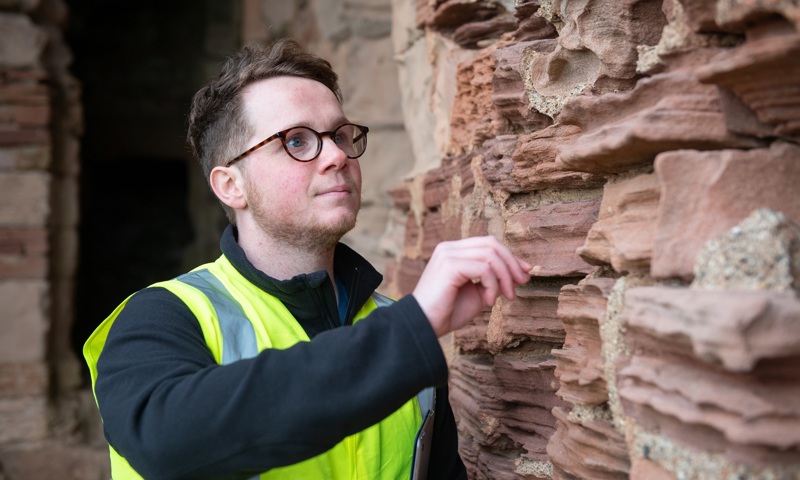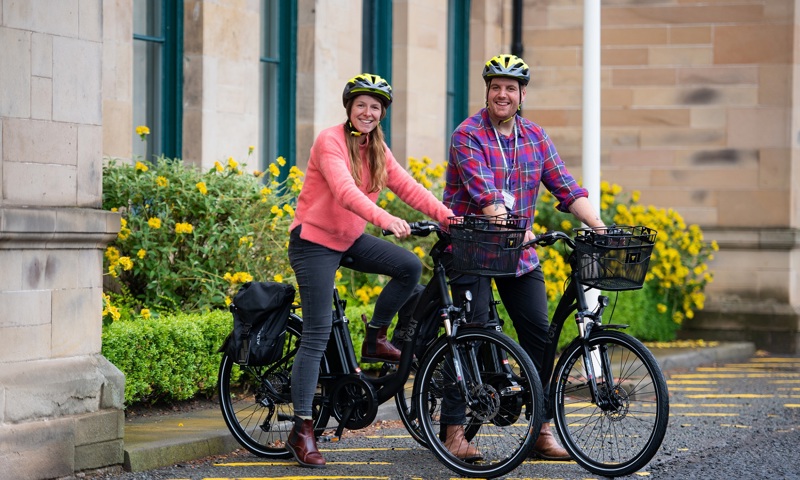1 Scotland's climate emergency
Our historic environment is on the front line of climate change. We need to take significant and urgent global climate action now to protect our past for the future.
The need for climate action has never been clearer. We are in a climate emergency and our historic environment is already feeling the impacts. Not only are our castles at risk of coastal erosion and our forts threatened by floods. But the historic buildings in which we live, work, learn and socialise are also under pressure. We must all make radical changes in response.
We share the Scottish Government’s vision of a Scotland that plays its part in mitigating global climate change – and which is resilient and adaptable to its impacts. And our organisation is a major player in helping to achieve these goals.
A collaborative effort
We can’t face the climate emergency and its effects on our historic environment alone. Instead, we are working work collaboratively in Scotland and with partners across the globe.
How we tackle climate change as a lead public body in Scotland is firmly grounded in law and our approach can have far-reaching influence in the heritage sector and beyond.
Under the Climate Change (Scotland) Act 2009 and Climate Change (Emissions Reduction Targets) (Scotland) Act 2019, all public bodies in Scotland must:
- contribute to the ‘net-zero’ emissions target for 2045
- deliver adaptation programmes to increase resilience
- act in a sustainable way
Our climate action responsibilities go beyond our own operations. We also lead others so that they may actively contribute to climate action too.
Explore our Climate Action Plan
Find out more about our climate action ambitions for the historic environment.
Climate Action PlanContact
Climate Change Team
Historic Environment Scotland
Longmore House
Salisbury Place
Edinburgh
EH9 1SH
Telephone: 0131 668 8600
Email: climatechange@hes.scot
2 Research, education and training
Our historic environment is already feeling the impacts of climate change. It is under pressure from increasing temperatures, changing rainfall patterns, extreme weather events, shifting coasts and rising seas.
Some of Scotland’s most iconic historic sites are at threat, along with our natural heritage and our homes, workplaces, schools, roads and more.
These impacts pose new challenges for us, some of which call for innovative solutions. Continued research and engagement across our teams and with external partners around the world will fill knowledge gaps and let us develop new approaches. The more we know about the risks of climate change, the more we can do to help.
Climate research
We’re working to support Scotland’s historic sites to become more resilient and adapt to survive where we can, and to sensitively manage loss where we can’t. We research and monitor the effects of climate change on the historic environment for the benefit of Scotland and beyond. From this position of knowledge, we can put in place meaningful climate change adaptation and promote its benefits to a global audience.
- For a snapshot of our current insights, view A Guide to Climate Change Impacts on Scotland’s Historic Environment.
- To learn about the risks to the Properties in Care estate, read our Climate Change Risk Assessment of the Properties in Care of Historic Environment Scotland.
- Or find out about the new index we’re using to rapidly assess climate change impacts. Read the Climate Risk Assessment for the Heart of Neolithic Orkney World Heritage Property.
Energy and carbon management

Carbon management is how we reduce greenhouse gas emissions to mitigate the causes of climate change. Emissions result from our energy and water use, business travel and waste. We research energy efficiency measures for traditional buildings and share our findings to support efforts in the wider historic environment.
Learn about saving energy in traditional buildings, read our own Carbon Management Plan 2020 or visit the Engine Shed for building advice and conservation tips.
For advice on energy efficiency measures for traditional buildings, contact our Technical Research Team at technicalresearch@hes.scot.
Skills training and knowledge
Traditional skills can be used to keep our historic buildings in good repair, helping Scotland to move to a circular economy. Wider use of sustainable materials and construction techniques also supports Scotland’s emissions reduction targets.
To support better procurement of traditional skills and materials in the construction sector, we are developing a framework contracts that others can follow and offering apprenticeships to train people in traditional skills. We also provide grants and funding towards the cost of works to look after the wider historic environment.
3 Partnership working
Climate change affects us all. In this time of climate crisis, we must develop new and creative partnerships, and strengthen those that already exist.
Scotland already has a core of public sector bodies and supporting organisations actively working together to tackle climate change.
International engagement is growing as both Scotland’s leadership role and the value of collaboration in combating this global issue are increasingly recognised. We are championing this wider outlook as founding members of the Climate Heritage Network.
Find out how we worked with the Scottish Environment Protection Agency and British Geological Survey to gauge climate change risk on our estate:
Partnerships for biodiversity
Climate change brings specific challenges to managing biodiversity at the places that we care for. Extreme weather events can put trees and landscapes at risk. Changing weather patterns will alter the habitats of certain species.
We have many opportunities to help biodiversity flourish. Protection of Scotland’s historic sites from development has preserved local habitats and species. Many of the places that we care for support rare birds, bats, amphibians and invertebrates. Parts of these places may also form wildlife corridors that allow animals to migrate and plants to spread.

At Stirling Castle, two beehives have been installed in partnership with Plan Bee and Stirling High School to promote biodiversity.
Our partners on biodiversity include the RSPB and Scottish Natural Heritage. Together, we are taking proactive steps to improve the biodiversity value of Scotland’s historic sites and the wider historic environment.
Find out more
Climate Action Plan4 Our work, people and culture
Plans and strategies alone cannot solve problems. Changing behaviours is central to our approach to climate action.
To achieve our climate action ambitions requires our employees, partners, visitors, stakeholders and others to be on board.

Sustainable procurement and circular economy
How we source goods and services can bring about all sorts of benefits: environmental, ethical, social and economic. Applied well, procurement can encourage innovation, promote jobs and growth, and boost training opportunities. It can also open up contracts to smaller companies, supported businesses and third sector organisations.
Sustainable procurement shapes all of our activities to ensure that we use our purchasing power to this end – and to support Scotland’s transition to a circular economy.
We share the Scottish Government’s vision of a zero waste society. We want to maintain, repair, upgrade, repurpose, reuse and recycle everything we use in a continual loop, so that nothing is wasted. We conserve our historic buildings not only for the sake of our economy, identity and sense of place. Keeping them in use also reduces the carbon impact of demolishing and building new. To do this, we invest in training and education in traditional skills.
We are taking action to reduce our waste, develop reuse networks for surplus assets, and increase recycling. We are also exploring how to avoid creating waste in the first place.
Tackling litter is another priority.
Litter Prevention Action PlanSustainable travel

Sustainable travel means low-carbon and carbon-neutral modes of transport. We’re making changes to reduce our own carbon footprint from commuting and business travel. And we’re exploring more sustainable ways for visitors to travel to Historic Scotland sites.
To support low-carbon travel across our business calls for radical changes in our use of vehicles and fleet. We promote active travel like walking and cycling and alternatives to travel such as videoconferencing. We’re investing in electric vehicles, and also charging points for staff and visitor use.
Sustainable tourism
We are the largest operator of paid-for visitor attractions in Scotland and visitor numbers are growing. Yet, more visits means more travel emissions, more consumption and more conservation challenges.
It’s crucial to ensure that growth happens in a responsible way. We want Historic Scotland sites to be sustainable places to visit that respect the needs of local communities as well as our business.
To drive forward sustainable tourism across Scotland, we belong to the Scottish Tourism Alliance, hold awards for the Green Tourism Awards and work closely with local partners such as the Edinburgh Tourism Action Group. We also partner on World Heritage Site Management Plans.

